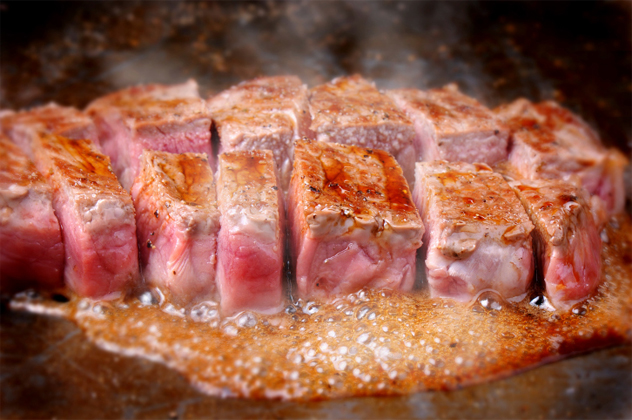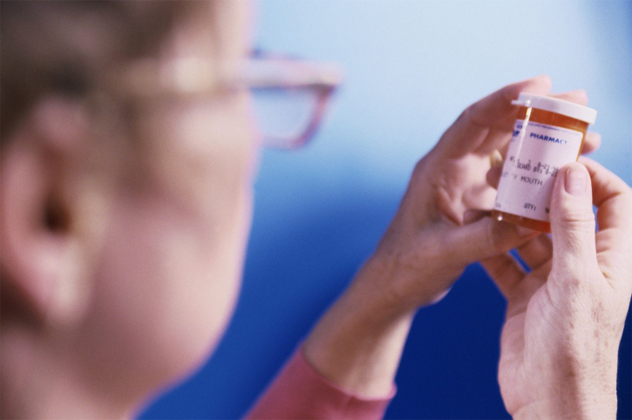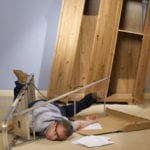 Mysteries
Mysteries  Mysteries
Mysteries  History
History 10 Surprising Stories About the Texas Rangers
 Humans
Humans 10 Philosophers Who Were Driven Mad by Their Own Theories
 Miscellaneous
Miscellaneous 10 Video-Game-Worthy Weapons and Armors from History
 Weird Stuff
Weird Stuff 10 Psychics Who Accurately Predicted Wartime Events
 The Arts
The Arts 10 Pieces of Art Inspired by a Broken Heart
 Health
Health 10 Science Fiction-Sounding New Medical Treatments
 History
History 10 Surprising Facts About the Father of Submarine Warfare
 Space
Space Ten Astonishing New Insights into Alien Worlds
 Weird Stuff
Weird Stuff 10 Bizarre Summer Solstice Rituals Still Practiced Today
 Mysteries
Mysteries Top 10 Haunting Facts About the Ghost Ship MV Alta
 History
History 10 Surprising Stories About the Texas Rangers
 Humans
Humans 10 Philosophers Who Were Driven Mad by Their Own Theories
Who's Behind Listverse?

Jamie Frater
Head Editor
Jamie founded Listverse due to an insatiable desire to share fascinating, obscure, and bizarre facts. He has been a guest speaker on numerous national radio and television stations and is a five time published author.
More About Us Miscellaneous
Miscellaneous 10 Video-Game-Worthy Weapons and Armors from History
 Weird Stuff
Weird Stuff 10 Psychics Who Accurately Predicted Wartime Events
 The Arts
The Arts 10 Pieces of Art Inspired by a Broken Heart
 Health
Health 10 Science Fiction-Sounding New Medical Treatments
 History
History 10 Surprising Facts About the Father of Submarine Warfare
 Space
Space Ten Astonishing New Insights into Alien Worlds
 Weird Stuff
Weird Stuff 10 Bizarre Summer Solstice Rituals Still Practiced Today
10 Things You Won’t Believe Are Being Counterfeited
You’ve likely encountered someone on the street peddling knockoff handbags or pirated DVDs. As far as crimes go, such industry ranks far beneath rape and murder, but it’s not without consequence. Counterfeiting has been estimated to cost the global economy hundreds of billions of dollars each year. Outside of its effects on the economy, fake goods have cost people their lives and have even been traced to the support of terrorist organizations. And counterfeiting is hardly limited to Louis Vuitton bags and $100 bills—literally anything that can glean a profit is faked, from medicine to food to entire cars.
10Extra Virgin Olive Oil

The vast majority of counterfeit goods are meant to imitate expensive items. While olive oil isn’t exactly cheap, it would hardly seem to be worth the effort of faking it. However, there is a huge market for counterfeit extra virgin olive oil, typically diluted with lower-quality oils, such as canola. According to Tom Mueller, the author of Extra Virginity: The Sublime and Scandalous World of Olive Oil, “Fifty percent of the olive oil sold in the United States is, in some ways, adulterated.” There are various guides available to advise consumers on how to tell the difference between real extra virgin olive oil and diluted imposters, but it is extremely difficult—even under laboratory conditions—to make the classification.
There have been several attempts to curtail the issue. In 2008, there was a huge crackdown in Italy called “Operation Golden Oil” that resulted in the arrests of 63 people and the confiscation of 63 farms. Most of the time, consuming less pure olive oil isn’t really a big deal. But in 1981, Spain was rocked by tragedy when rapeseed oil contaminated with aniline (a coal tar extract used as an industrial lubricant) was sold as olive oil. Nearly 700 people died and countless others suffered injuries that included paralysis, organ failure, deformed bones, and neurological problems.
9Beanie Babies

For those too young to have lived through it, it is difficult to explain how frenzied the market was for Beanie Babies in the mid-to-late ’90s. Distributed by Ty Warner Inc., Beanie Babies were a series of small stuffed animals of various species. The immediate appeal is obvious, but Ty played the market by making their product intentionally scarce to drive up demand. Limited quantities were distributed to stores, and models were often “retired,” rendering certain specimens extremely valuable.
The craze often got bizarre. In 1999, a divorced couple, unable to split up their extensive Beanie Baby collection on their own, was forced to divide them one at a time on a Las Vegas courtroom floor before a judge. The market has since bottomed out, but the rarest models, such as the limited edition commemorative Princess Diana edition (issued in the wake of her untimely death), are still claimed to be worth hundreds of thousands of dollars. (This is, of course, untrue—no one would pay that much for a Beanie Baby.)
Counterfeit Beanie Babies were inevitable. People even began faking the toy’s tags. In 2000, two men were arrested at a banquet hall in Willowbrook, Illinois, after an undercover investigation featuring police, state attorney’s detectives, and Ty security staff. Fake Beanies are so common that dozens of websites have sprung up aiming to teach consumers the telltale signs of a forgery. Unlike some other counterfeits, Beanie Babies were even tied to a minor political scandal—1998’s “Beaniegate,” when United States Trade Representative Charlene Barshefsky was stopped by customs after visiting China on a diplomatic summit with then-President Bill Clinton. Barshefsky was found with approximately 40 fake Beanie Babies in her bags. The contraband was eventually incinerated.
8Kobe Beef

Like truffles or caviar, Kobe beef is the very definition of a culinary delicacy, fetching prices over $200 a pound. The exquisitely marbled beef, whose fat has a lower melting point than regular beef, is said to be without peer. However, to call a cut of meat Kobe, there are several restricting conditions: It must come from Tajima cattle born, raised, and slaughtered in the Hyogo Prefecture, among other requirements. Until 2011, Japan did not even export Kobe beef, so unless you’d been to a Tokyo steakhouse, there was no way you’d ever tasted it.
So you might wonder how every other restaurant you go to seems to have a (often exorbitantly expensive) Kobe beef item on their menu. The answer is simple—while the term “Kobe beef” carried legal trademarks in its native Japan, in the United States, the term is wholly unregulated. As long as the restaurant calls it beef, they can feel free to describe it in any way they see fit.
In 2012, the USDA relaxed its stance on beef imported from Japan provided the Japanese slaughterhouses were inspected and conformed to all standards upheld by American slaughterhouses. However, the amount of meat actually exported is still incredibly small, and it’s difficult to obtain among a sea of imposters. One of the few places in the US to serve legitimate Kobe beef is the Wynn Las Vegas casino, but beware—you’ll need deep pockets to enjoy this treat.
7Condoms

A great many of us are born as the result of “happy little accidents.” Still others have a decidedly more ridiculous origin—the children of fathers who skimped on prophylactics and bought knock-off condoms. In 2013, a Chinese police officer noticed condoms for sale on a website at an exceedingly steep discount. He purchased some for testing, only to discover that they were poor-quality fakes.
The condoms were in turn traced to a series of black market factories in the Fujian, Zhejiang, and Henan provinces. An astonishing 4.65 million condoms were found packaged under recognized brand names like Durex. Another 500 kilograms (1,100 lb) of material stood by ready to be wrapped. The racket was actually absurd in its simplicity—the makers purchased raw latex and treated it with cheap lubricant. The condoms were produced for around $0.03 USD and sold for $0.16 USD.
The counterfeit rubbers were mostly distributed online but were also peddled through various underground vendors. Perhaps not surprisingly, they also found their way to Africa, an area already ravaged by sexually transmitted diseases. According to Thomas Amedzraof, the Ghanaian Food and Drug Authority, “When we tested those condoms, we found that they are poor quality, can burst in the course of sexual activity, and have holes which expose the users to unwanted pregnancy and sexually transmitted disease.”
6Malaria Medication

Many cases of counterfeit goods are largely without consequence save for the bottom line of legitimate sellers, but those who fake malaria medication literally have the blood of thousands on their hands. In the Western world, many of us tend to think of malaria as some kind of relic of the past like black plague or polio, but it’s still very active, particularly in Africa. According to the World Health Organization, an estimated 198 million people contracted malaria in 2013, with over 500,000 dying of the illness.
One of the drugs being faked is Coartem, a regimen of 24 pills taken over three days developed by pharmaceutical company Novartis. Coartem vastly reduces the mortality rate of malaria. Although the drug is often provided either free or deeply subsidized, huge numbers of fake pills are being imported to Africa from China. In most places in Africa, there is very little control over pharmaceuticals, and they are often peddled on the street. Counterfeit pills have been found in at least 11 different African countries that contained very little Coartem or none at all, a problem which is reportedly on the rise according to the National Center for Biotechnology Information.
5Cheese

People around the world have long mocked the bland palates of Americans, who happily consume things like Wonder Bread and spaghetti out of cans. Nowhere is this more obvious than their taste for cheese. One of the more popular variants in the US is “American” cheese, often sold in packets of individually wrapped slices. Very nearly a counterfeit in its own right, this product is so heavily diluted that it cannot even be legally sold as cheese, but as “cheese food,” which is just about as appetizing as it sounds. However, in Europe, cheese is taken with deadly seriousness.
Switzerland is famed for their many variants of cheese, including Emmental and Gruyere. Like champagne, which can only call itself that if the grapes are grown within a very specific geographical area, the Swiss have exacting rules on how their cheeses can be produced. Unfortunately, fakes began to appear on the market, particularly in Italy, leading to a decline in sales. To protect this lucrative industry, the federal government has established a bank of 10,000 strains of milk bacteria DNA, a project that took scientists a decade to complete. The bacteria is kept frozen in a facility in the city of Bern. These samples are used to test against suspected forgeries, and spot checks are often conducted in markets.
4Cars

The global masters of fakery, the Chinese even peddle such sophisticated counterfeits as complete cars. Around 2000, a rash of Volkswagen lookalikes began to make the scene. Then, the storied Chery QQ (based on the Chevy Spark) was released. At one point, the Chery QQ was one of the cheapest cars in the world, available for under $5,000 brand new. Today, Daimler Chrysler’s Mini is the du jour counterfeit, with at least three different Chinese firms pushing their own versions.
Legal actions against the Chinese firms pushing knockoffs have proven largely fruitless. The real mystery is how the Chinese can peddle these cars for less than half the price of those made by legitimate manufacturers. While they would certainly escape the costs of research and development by using hijacked blueprints, that they continue to make a profit despite the costs of construction and raw materials indicates that there might be something even darker at play.
3Stradivarius Violins

Like expensive wine and Beats by Dre headphones, Stradivarius violins are probably overrated. Various tests have been conducted which prove that music experts cannot distinguish between their sound and that of other quality violins. Nevertheless, violins constructed by the family, particularly Antonio Stradivari, an Italian luthier who lived from 1644 to 1737, command outrageous prices. In 2014, Sotheby’s put a viola made by Stradivari up for auction—for $45 million (buyers failed to meet the minimum asking price). In 2011, Tarisio auction house sold a 1721 Stradivarius violin called the Lady Blunt for an eye-popping $15.9 million. And anywhere such outrageous sums can be generated, counterfeiting is sure to follow.
Unlike many other knockoffs, counterfeit violins are often extremely sophisticated. Experts have to be extremely skilled to detect the subtle differences. Besides blaring inconsistencies, the first line of defense against fakes is to determine if the instrument is old enough to have been made by Stradivari. This is accomplished through a process called dendrochronology—studying the tree rings to put an age on the wood used to build the instrument. The varnish on the violin can also be analyzed to test for chemicals that Stradivari would not have used. As you might imagine, neither of these processes is exactly clear-cut. The best defense against counterfeit violins is technology—networks of people who can archive their expertise and collect photographs. Of course, all this knowledge is also available to the counterfeiters, who only refine their technique more.
2Ketchup

Ketchup isn’t a big-ticket item. In the United States, nearly every restaurant offers it for free. But as we’ve seen, there is no limit, no scant profit, that counterfeiters will not strive toward. In October 2012, a bizarre story emerged from a private warehouse in Dover, New Jersey. People leasing space in the building reported exploding containers of ketchup, which in return attracted hordes of flies. The ketchup in question was “Simply Heinz,” a premium version which uses sugar in its recipe instead of high fructose corn syrup.
It is believed that regular ketchup was added to the Simply Heinz bottles with fake labels. Exposed to the air and possible adulterants, fermentation began, and the sugar in the ketchup reacted with the acidic tomatoes and vinegar to release gases that caused the bottles to detonate. An investigation was conducted by Heinz, whose spokeswoman claimed that the company “has not discovered any information that leads us to believe the illegally repackaged product is on the market.” According to Michael Mullen, Heinz’s vice president of corporate and government affairs, “The site of this operation was abandoned and had produced only a small quantity of bottles, much of which was still on site.”
1Apple Store
Dubbed by some as the world’s most valuable brand, it will come as no surprise that Apple products—which range in price from hundreds to thousands of dollars—are frequently counterfeited. Often, they aren’t even particularly good fakes—just weighted glass frames designed to replicate iPads. In a typical street transaction, by the time the buyer recognizes that he’s been defrauded, the seller is blocks away and picking up speed.
In fact, Apple is so popular that entire fake stores have sprung up in China. In 2011, a shocking 22 counterfeit Apple stores were discovered in Kunming, some with incredibly elaborate detail, from the trademark company uniform of blue shirts and lanyards down to architectural trademarks like Apple’s winding staircases. However, like most fakes, there were subtle differences, such as misspelled signage advertising the “Apple Stoer.” After an American posted photos of this ruse on a blog, Chinese authorities swept in to shut the stores down. Of course, this did little to stem the tide; merchants began offering knockoff Apple watches in March 2015, even before the official version’s release date.
Mike Devlin is an aspiring novelist.








